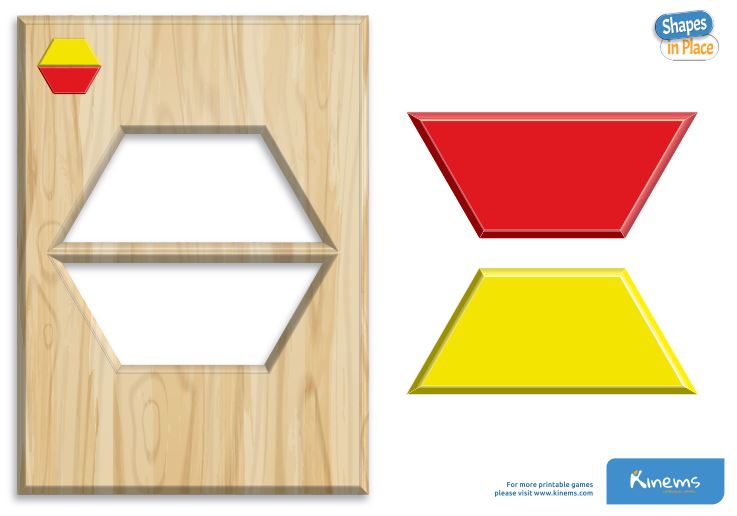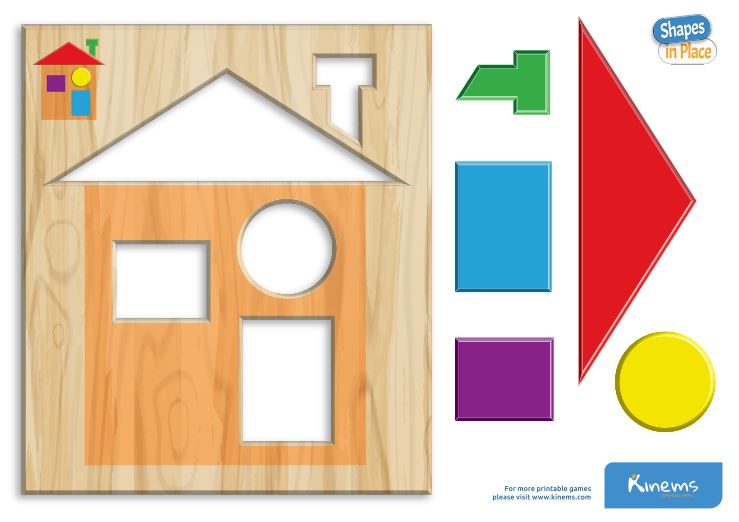Printable Board Game for Preschool, Kindergarten & 1st Grade | Shapes in Place

Learning shapes and colors is one of the most entertaining activities for young children!
The Shapes in Place Board Game promotes eye-hand coordination, puzzle making, naming and recognizing geometric shapes and colors as well as critical thinking development.
Shapes offer a strong foundation for learning letters and numbers during preschool and kindergarten. Differentiating one shape from another and knowing their characteristics will help your child to eventually identify letters and numbers easily. The ability to understand shapes also helps in solving problems in future math experiences, in geometry, and in logical reasoning.
Download Shapes in Place Board Game
In the Shape in Place Game, simple 2 dimensional geometric shapes are used to form larger shapes and real-world objects. They must choose a colored shape and place it in the appropriate shape place for it in the picture. This colored picture-puzzle helps children expand their vocabulary in naming colors and shapes. They learn to recognize shapes based on their characteristics and reinforces their ability to categorize and sort shapes. They place different shapes in creating real-world image representations of a boat, a house, a recreational vehicle, train and a rocket.
This strengthens problem solving, concentration, and fine motor skills such as grabbing and hand stability. When students attempt to position a shape in its place, it will fit if it is properly put in the right space. This also is a puzzle skill as well as predicting by using visual clues.
How to play
Game 1
Cut out the shapes on each page for pages 2-7. Have your child place them in each of the designs. You can glue them on or simply place the shapes so it can be played again. Or print two pages so you have additional shapes to cut out. Discuss the names of the shapes and how many sides make up each shape.
Game 2
Cut out the shapes on pages 8-12. Again, you can have your child simply place them on the object or glue them.
After assembling the objects, they can color them in and label them. You can emphasize vocabulary by asking questions about the object. Where is the roof of the house? What shapes are the windows? What shape is the door? What color is the door?
Game 3
Challenge your child to use all the shapes from both games to create their own designs. Tell them it can be a collage or design that doesn’t have to represent a real object. They can just arrange the shapes in whatever way pleases them. Praise creativity!
The following standards are aligned to this Game
Preschool and Kindergarten
- Model shapes in the world by building shapes from components (e.g., sticks and clay balls) and drawing shapes.
- Compose simple shapes to form larger shapes. For example, "Can you join these two triangles with full sides touching to make a rectangle?"
First Grade
Compose two-dimensional shapes (rectangles, squares, trapezoids, triangles, half-circles, and quarter-circles) or three-dimensional shapes (cubes, right rectangular prisms, right circular cones, and right circular cylinders) to create a composite shape, and compose new shapes from the composite shape.
Other fun ways to use shapes
- Have your child use the shapes like a stencil. If you print on heavier paper, this will be easier. They can make a “challenge” puzzle for you to do by drawing around the shapes on a piece of blank paper.
- If you made two copies of one of the shapes pages, you can make a design on the table or on a blank paper with one set and have your child make a copy of that design.
- Go on a “shape” hunt! Go around the house looking for objects that are rectangles or triangles or circles. Make it a contest for which family member finds the most shapes in real objects.
- If you have glue and yarn, you can glue the yarn around the edges of the shape. This makes a very sensory way to emphasize the sides of the shapes and the circle. You can also cut paper strips to glue around the edges as well.
- You can use toothpicks to make shapes with straight edges. If you have pipe cleaners, it will be easy to make circles. Yarn or ribbon works well.
- Make shapes by cutting a clean plastic milk carton with strong scissors. Use these shapes as stencils. Use Play-Doh to make shapes. You can make balls and flatten them for circles. You can make “snakes” to make straight edged shapes.
- Tape the shapes on the floor in a hallway or open space. Take a shapewalk. Give instructions like: Step on the blue triangle, then the red square and then the green square. Have them make you take the shapewalk giving you the instructions.
- Make a shape scavenger hunt. Hide shapes around the house. Depending on the age of your child, you might want to have some of the shape showing from under a pillow or in a drawer. Have the family participate and make it a competition for who finds the most shapes!
- If your child has a set of parquetry blocks, use those as stencils and to make patterns.
- You can move to cubes and cylinders by examining your food pantry. This way you introduce three dimensional shapes.
- If your child has blocks in these three dimensional shapes, use them to teach their names and characteristics.

